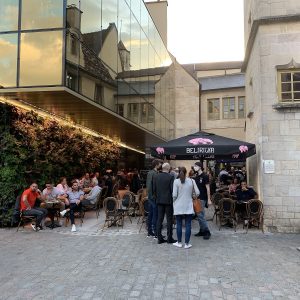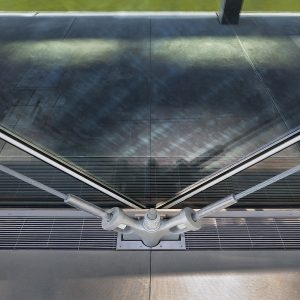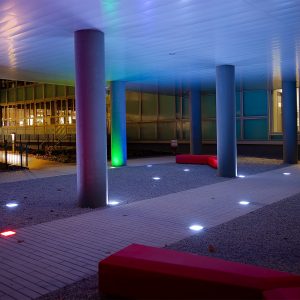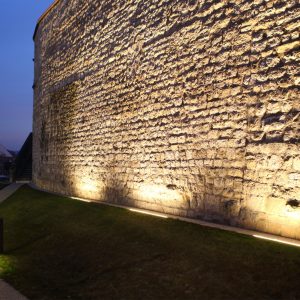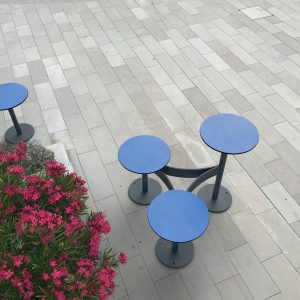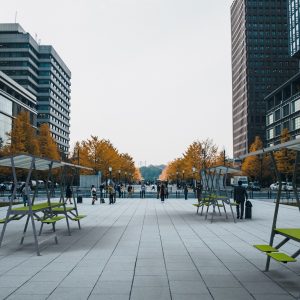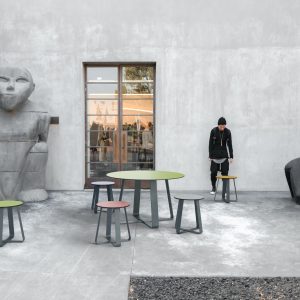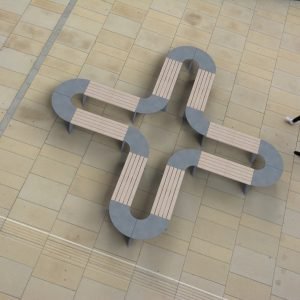(Co)Designing Hope: Aqueous Landscapes in Transition by Laura Cipriani

Laura Cipriani is an assistant professor of landscape architecture at Delft University of Technology and a founder of Superlandscape, a landscape and urban design firm. She holds a Ph.D. in Landscape Urbanism from IUAV, a master’s degree in landscape and urban issues from Harvard Design School, and a master’s in Architecture from IUAV. Her current research addresses climate change issues, starting from the materiality of water and soil, and adopting (co)design approaches. She authored and edited several books, including recently “Fluid Soils. (Co)Designing for the Wadden Sea Landscapes”. This year, “(Co)Designing Hope: Aqueous Landscapes in Transition” was published with Routledge, featuring numerous projects and research on the “body of water,” including contributions by landscape architects, geographers, academics, engineers, and artists.
We spoke with Laura about the book and the state of water.
The book opens with Antoine Lavoisier’s quote: “Nothing is lost, nothing is created; everything is transformed.” This quote references the water cycle and its transformations from liquid to gas to solid state. Water is omnipresent, in soils, underground, air, rivers, and oceans …
I love the quote from Lavoisier. Transition is a process; water is always unstable since it constantly moves in the water cycle. From the soil to the groundwater. From rivers to the ocean. From the sea to the atmosphere. Evaporation, transpiration, condensation, precipitation, infiltration, surface runoff, and subsurface flow are the physical processes of this constant movement. Today, climate change upsets water cycles and evaporation phenomena, increasing extreme weather events, droughts, and floods, but the global water balance at the planetary level remains essentially constant.
The quote also encourages us not to despair and wait for hopeful times; we are in the process of transformation. That’s why this book gathers essays on aqueous landscapes facing climate change challenges and hopes that can spring from collective design in its broader meaning, involving all living and non-living systems.
Ten Axioms concerning water are proposed: Uncertainty, Inertia, Catastrophe, Time and Timeliness, Palimpsest, Cultural Landscape and the Imaginary, Climate Injustice and Design Imperialism, Economy, and Hope, with a focus on the Axiom of Design. Each axiom poses an entry point to this complex issue. How to (co)design (with) water with all the mentioned axioms in mind?
Climate change has prompted a radical shift in design approach. Working with rather than against water has opened up new possibilities for collaborative design. (Co)design or collaborative design is meant to highlight landscape design as the product of a plural, collective symphony that involves or originates from living systems and natural forces. From hydrologist to botanist, fisherman to farmer, swallow to fish, rain to wind, all of Earth’s systems constantly draw landscapes. The actors involved in the collaborative dance of the cosmos incessantly design landscapes within a complex and often indecipherable plan. Their actions are the conscious products of a will and sometimes the unconscious result of a need, an adaptation, or a chance. Therefore, thinking in (co)design means expanding humans’ gaze and involving living and non-living things, such as people, animals, plants, water, ice, fog, wind, sand, and rocks, which contribute to the cosmos’ landscape symphony. Consider, for example, the work by Georges Descombes that reconfigured the riverbed of the Aire River in Switzerland by working with sediment flows. The river becomes the (co)designer, (co)drawing its new route.
I felt it essential to set out ten “axioms,” observations, notions, and ideas on landscapes, the water and climate crises, and (co)design. Defining certain axioms concerned with uncertainty and change is undoubtedly a risky undertaking—oxymoronic, almost—but I feel it helps crystallize specific familiar issues and identify what routes might be taken when discussing aqueous landscapes in the climate crisis.
The axiom of design is the one that I care about the most. Design is crucial to getting out of the different crises we face. It is addressed through some corollaries: the Corollary of Collaboration and Interscalarity, (Co)Design by People, Animals, and Nature, Design Error, New Paradigms, and Simplicity. The climate crisis prompts and demands a change in the paradigm, design, and tools employed. In short, climate change(s) design.
How to grasp water?
We cannot “grasp” water but can design with it even while it transforms from one state to another. That’s why I decided to structure the book as the water cycle in transition. The essays are organized into the three states of water relating to climate change—liquid, solid, and gas. The opening section, “Liquid | Water,” discusses collaborative design practices in coastal and riverine areas. The second section, “Solid | Ice,” which might sound like an oxymoron at present, questions the solidity of ice in the era of climate change. The projects noted in this section represent an attempt to raise public awareness and engagement on the issue of climate change while also highlighting unexpected examples of the hopeful adaptation of some local communities. The final section, ‘Gas | Fog and Clouds,” collects design practices related to the third state of water. These include projects and natural phenomena dealing with water and atmospheres, comprising landscape practices and artistic interventions aimed at “making water” from clouds, fog, and moisture.
In the Introduction, you point to the crisis, which can be alleviated by hope and working with the landscape. But the crisis you see is not only about the extreme climate events we are facing. More far-sighted and imaginative solutions are required.
Among the many current crises, I see two as being particularly significant. The first, which concerns the climate, is well known and we are now seeing how serious the outlook has become. Extreme events, droughts, floods, shifts in precipitation and temperature patterns, melting glaciers, sea level rise, water salinization, and general changes in the water cycle remind us that the climate crisis is mostly a water crisis. The second—and perhaps even more serious—is a crisis of imagination that is connected with thoughts and creative, far-sighted actions capable of combining the visionary and the pragmatic.
Notably, design and designers seem less relevant in the climate discourse. Most books and publications outside the design realm focus on the hazards of the climate crisis, rather than on the possibilities it might offer us. Most academic publications prefer to quantify and define the problem, proposing standardized solutions and toolkits rather than offering site-based designs for climate adaptation and mitigation that allow us to (re)think the territory in all its social, economic, and aesthetic dimensions.
The discipline of landscape architecture can respond to these two crises. This has always featured an interdisciplinary approach focusing on water, environmental, and ecological issues, the involvement of collectiveness in the design process, and the inclusion of the time variable in future plans—yet without neglecting the necessary flexibility of creative and pragmatic thinking.
As we will sustain in this book, Hope considers the potential of imagination that landscape architecture can drive through a collective (co)designed practice. Hope is a project of change and a project of action. The Indo-European root of hope (speh-) refers to moving toward a destination and, therefore, changing direction toward a probable and desirable future—a confident optimism of one’s destiny and that of the world. Thus, Hope is linked to the concept of landscape, an active hope that sets man and natural forces in motion. It is a choice between destructive pessimism and constructive pessimism: our preference as designers is for the latter.
But beware, we must not look for solutions; I prefer looking for possibilities. The idea of possibility entails plurality, the opening to creativity and pragmatism, whereas the term solution is often isolated, purely technical, and frequently short-sighted.
The book revolves around water which confluences landscape design whether for flood resilience, sea level rise, drought or the loss of melting landscapes, including contributions by landscape architects, artists, climatologists, geographers and related researchers.
The projects discussed in the book are located worldwide at different geographical latitudes and longitudes with specific climate and water conditions, showing the multiplicity of strategies, approaches, site-specific interventions, manifestos and manifestations of thought. Please explain how you selected the contributions and projects, what can you point out?
This book gathers essays on aquatic landscapes facing climate change challenges and hopes that can spring from collective design in its broader meaning. Through exploring landscapes at different scales, the book focuses on landscape design grounded in different geographies and cultures where (co)design involves all living and non-living systems.
Drafting the ‘axioms’ for the landscape in transition was the seed of this book, which led me to contact the contributors for each topic outlined. I started thinking about which design projects could be included in this discourse. I invited a wide range of academics from multiple institutions around the world, and designers gladly joined the reflection. I was delighted to have personalities like Georges Descombes, Gilles Clément, Catherine Mosbach, and others on board.
Please describe the “cloud gardeners” and the cultivation of clouds. It perhaps best shows working with the invisible yet present body of water.
The “gardeners of the clouds” are humans, animals, and plants capable of “cultivating” water in conditions of scarcity, starting from clouds, fog, frost, and dew, and adapting to often extreme and inhospitable climates. Designing—or rather (co)designing—together with atmospheric phenomena allows us to explore new (co)design techniques and open our imagination to new possibilities.
In some regions of the world where it never rains, plants and animals live. In the Namib Desert, the unpredictable phenomenon of fog sustains the fauna and flora, for example. Two species of beetles, Onymacris unguicularis and Onymacris bicolor, actively collect fog by basking in the mist and capturing tiny droplets of water through the grooves of their carapace, finally conveying them to their mouths. Other beetles make structures to capture fog. Some animals are even equipped with long-term internal water storage mechanisms to overcome unpredictable and episodic foggy events. Even plant species such as Stipagrostis sabulicola rely predominantly on fog for their water supply. The superficial structures of their leaves convey the collected water toward the base of the plant, allowing the efficient and rapid absorption of the atomized water by their superficial roots.
These are the “cloud gardeners” who can “cultivate” rain. And we can learn from them and their ecological and adaptable technologies. This is in very contrast to techniques to induce precipitation developed by the engineering sciences, such as the so-called “cloud seeding” that disperse certain substances—including silver iodide, dry ice, or salt—using planes, cannons, or ground devices.
Emily Knox and Rob Holmes conclude the book by alluding to the “choreography” of all planetary forces involved, subtly suggesting that humans are (or should accept the role of) conductors attuned to the cosmos.
I love the term “choreography” that Emily and Rob emphasized. They understood what I was looking for in the very essence of this book. The beauty and technique of this natural performance remind us that (co)design requires both of these factors, especially in times of crisis. Hope entails a choreography, a dance in the cosmos, with the cosmos.
This book was actually supposed to be entitled “The Dance of Hope,” but I feared that most people would not have understood the content and book genre. There are many dances. Water is dancing and transforming in its states, but it is also moving, driven by the moon, for example, and rotational-gravitational forces. As living beings, we also dance and constantly design the landscape. The dance immediately conveys a sense of harmony, an aesthetic procedure driven by highly technical movements. This is the view I think we need to achieve, considering climate change and the water crisis. Do not concentrate solely on the problems—the wrong steps in the dance. This leads to impotence and inaction. We must look for a positive attitude—the only way to lead to change and action. As we said before, it is a choice between destructive pessimism and constructive activism. Our feet and bodies must listen to the world’s music—the ancient “Harmonia Mundi”—and adapt to it collectively, orchestrating narrower and broader changes that attempt to listen to the Earth’s possibilities.
- The collective landscape dance of a flock. Photographs by iStock.com/AGD Beukhof
Published on November 18, 2024






